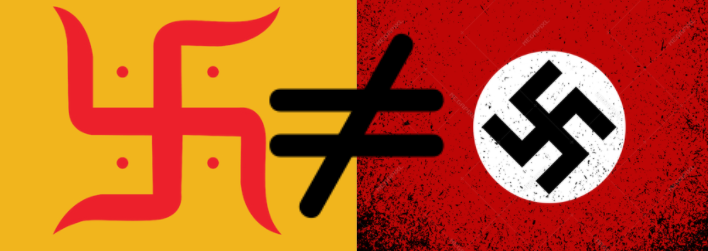Foreign media’s obsession with India is not new, more so, with the customs and beliefs of the country where culture forms an intricate part of our lives. However, one of the biggest binding factors that unite the Hindus is the pious ‘Swastika’ symbol, used before any auspicious ritual in a Hindu Household.
Swastika, a Sanskrit word is a combination of ‘su’ (meaning ‘good’) and ‘asti’ (meaning ‘to exist’) — often translated as ‘all is well’. It is a symbol central to Hindu, Buddhist, and Jain spiritual life, invoking wellbeing and prosperity.
However, the foreign media, especially the New York Times, infamous for its bigotry, racism, and supremacist views, through its sheer propaganda has equated the Swastika with the barbaric, anti-Semite, Christian symbol of ‘hooked cross’ used by Adolf Hitler and his legion of Nazis.
Not only did NYT not cover Holocaust, but it also distorted the Hindu symbol and its meaning.
With American author Ashley Rindsberg’s releasing his book titled “The Gray Lady Winked: How the New York Times’s Misreporting, Distortions & Fabrications Radically Alter History” the spotlight has once again shined on NYT.
Reportedly, the news publication claiming to speak truth to power did not cover the Holocaust and only published six front-page articles in six years when the genocide took place, according to Ashley and simultaneously, distorted the Hindu symbol.
Hooked cross – a Christian symbol
It is imperative to note that the Nazi Party adopted the hooked cross (Hakenkreuz in German) as its emblem in 1920. There is no evidence that Hitler ever heard of the word “Swastika”. Hooked Cross had been a sacred symbol of Christianity since its inception in ancient days and it is very natural to find Hooked Cross symbols in old churches and chapels.
The Christian symbol had nothing to do either with Hinduism or Swastika. It existed as an important symbol of Christendom since its very existence. It was found in early Christian Graves of Rome in the second century CE.
True Indology, in one of his posts, had remarked that hooked cross motifs were present on the ceiling of Pope’s official residence, Sistine Chapel, Vatican City.
https://twitter.com/bharadwajspeaks/status/1337100262901571584
Moreover, according to Hindu American Foundation (HAF), in the crude translations of Adolf Hilter’s “Mein Kampf” into English, Hakenkreuz was substituted for the Swastika, thereby popularising the notion of a “Nazi swastika.” Doubling down on the confusion, after 1933, NYT actively started using the term Swastika instead of Hakenkreuz.
But, a Mar. 19, 1933 article in @nytimes essentially "discovered" the Swastika for popular American mainstream, conflated it with Hitler's symbol. Even then, the paper use the word "hooked cross" and Swastika interchangeably (the hooked cross dropping eventually over time). 3/n pic.twitter.com/ltDQQqPfn0
— CoHNA (Coalition of Hindus of North America) (@CoHNAOfficial) October 27, 2021
While the NYT made the cardinal sin of equating hooked cross with Swastika, other foreign media portals continue to do so even today. As reported by TFI, in 2018, Reuters tweeted that they had removed a picture of former US envoy Nikki Haley next to the swastika, claiming it resembled the Nazi symbol and they should have never posted it.
Reuters has removed an earlier photo of U.N. Ambassador Nikki Haley with a swastika seen behind her at a Hindu temple in Delhi. The swastika is an ancient religious symbol for Hindus and Buddhists. It was also used as a symbol by Nazi Germany https://t.co/rQa4VcIOdy pic.twitter.com/rJTUjd8C4f
— Reuters India Photos (@IndiaPhotos) June 28, 2018
Read More: US to ban Hindu Swastika: Hindu Swastika is not Nazi Swastika, but Joe Biden thinks otherwise
In the 21st century, those who have revered the Swastika for generations spanning millennia are being asked to give up on their sacred symbol because the English made a mistake in labelling a line formation. There was no need to use a Sanskrit term to label a line formation dating back to pre-Christianity Europe.
There is no evidence to suggest that the Indian symbol has any relation to the European one, other than simple coincidence. However, the NYT and the other liberal publications have never been one to accept cold, hard facts. Propaganda and misinformation always take the front seat and it is not a new phenomenon.
